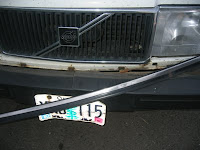
For the audience with the Pope, Bill wore a dark suit and tie and I wore a long skirt and long sleeved blouse in dark colors as suggested in our information packet. Dark colors on hot days add up to a bit of discomfort. Many either didn't know or had discarded the bit of information about dark colors, and had come more wisely dressed in light shirts and slacks but from the absence of color in this photo one might think I'm exaggerating.

We thought the audience was beginning, when a monsignor got up to announce his group from Germany; but no, this prelate went on and on, introducing every school, college, seminary, and church there. And then, alas, we had another long wait.

As you can see, veryone is stretching to catch that photo, jumping onto their chairs which made it difficult to see over their heads. From our vantage point, the pope is a tiny white spec in the middle of the photo.

"7But whatever was to my profit I now consider loss for the sake of Christ. 8What is more, I consider everything a loss compared to the surpassing greatness of knowing Christ Jesus my Lord, for whose sake I have lost all things. I consider them rubbish, that I may gain Christ 9and be found in him, not having a righteousness of my own that comes from the law, but that which is through faith in Christ—the righteousness that comes from God and is by faith. 10I want to know Christ and the power of his resurrection and the fellowship of sharing in his sufferings, becoming like him in his death, 11and so, somehow, to attain to the resurrection from the dead." The Holy Father commented on these verses urging us to know Christ and to make Christ the center of our lives. Though our Italian is limited, Bill and I understood, almost as if we were participating in the first Pentecost when all those listening to the apostles heard them speaking in their own languages.

To see historic Rome cheaply and at your leisure, take the #110 open archeobus from Termini – an inexpensive way to tour all the important city sights. One ticket allows the rider to get off whenever they wish to tour a particular site and to get back on another #110 bus when they are ready to continue the tour. Don't count on being able to listen to the tour descriptions however. On each open air bus #110 bus we took, people were continually moving from place to place trying to earphones that worked. Bill and I gave up and simply enjoyed the ride and the sights.
The view is splendid the top of the #110 bus, and from its lofty height I caught sight of Sister Clare Andre, a nun from my old monastery in New Jersey waiting in line. I yelled to her from the top of the bus but she didn’t hear us. Click here to read the earlier post telling of the chance and amazing meeting with Sister Clare Andre while waiting in line at the Vatican for tickets to the Papal Audience.
















































